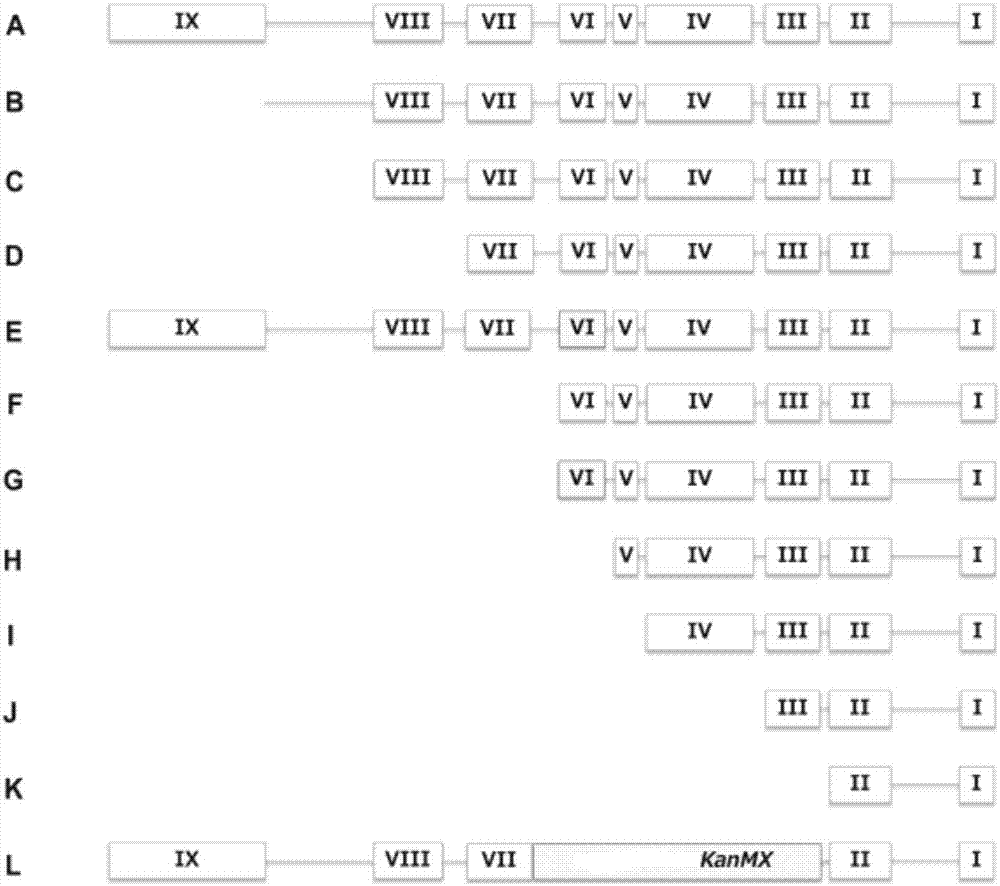Promoter and recombinant yeast strain
A technology of yeast strains and Saccharomyces cerevisiae strains, which is applied in the field of genetic engineering to achieve the effect of increasing production and excellent production capacity
- Summary
- Abstract
- Description
- Claims
- Application Information
AI Technical Summary
Problems solved by technology
Method used
Image
Examples
Embodiment 1
[0064] Embodiment 1: promoter described in the present invention
[0065] Based on the ALD6 full-length promoter, the corresponding promoter was obtained as follows:
[0066] The B promoter is a promoter for knocking out the IX sequence;
[0067] The C promoter is a promoter for knocking out the sequence (1-629bp) comprising IX;
[0068] The D promoter is a promoter for knocking out sequences (1-629bp, 630-700bp) comprising IX and VIII;
[0069] The E promoter is a promoter that performs base conversion mutation on the entire sequence of VI;
[0070] The F promoter is a promoter for knocking out sequences (1-629bp, 630-700bp, 701-845bp) comprising IX, VIII and VII;
[0071] The G promoter is a promoter that performs base conversion mutation on the entire sequence of VI on the basis of the F promoter;
[0072] The H promoter is a promoter for knocking out sequences (1-629bp, 630-700bp, 701-845bp, 846-915bp) comprising IX, VIII, VII and VI;
[0073] I promoter is the promot...
Embodiment 2
[0078] Embodiment 2: Shake flask fermentation test (comparison between the full-length promoter and the promoter of the present invention)
[0079] 1. Construction of test strains
[0080] Basic strain:
[0081] Referring to the records in the patent CN105087406A, the three genes gal1, gal7 and gal10 in Saccharomyces cerevisiae CEN.PK2-1C were knocked out to construct recombinant Saccharomyces cerevisiae strain A (control strain, corresponding to the full-length promoter A);
[0082] Referring to the records in the patent CN105087406A, the three genes gal1, gal7, and gal10 in Saccharomyces cerevisiae CEN.PK2-1C were knocked out, and the C, D, E, F, G, H, K, and L promoters in Example 1 were passed The original ALD6 promoter was replaced by yeast homologous recombination, and the recombinant S. cerevisiae strains C, D, E, F, G, H, K and L were constructed, corresponding to their own promoter numbers;
[0083] Geraniol producing strains:
[0084] Integrating gene fragment 1 a...
Embodiment 3
[0113] Embodiment 3: Shake flask fermentation test (removal of the conservative sequence and the comparison between the sequence promoter containing the conservative sequence)
[0114] In order to verify that the conserved sequence is the main influencing factor, the present invention provides the following groups of promoters whose difference is only whether there is a non-conserved sequence, and constructs recombinant strains according to the method in Example 2 to compare the yields of various terpenoids. The results are shown in the table 1.
[0115] Group 1: promoter B and promoter C, the difference is that promoter B has a non-conserved sequence of 378-629bp more than promoter C;
[0116] Group 2: promoter I and promoter I+926-940bp non-conserved sequence;
[0117] Group 3: promoter J and promoter J+1117-1183bp non-conserved sequence;
[0118] Table 1
[0119]
[0120]
[0121] It can be seen from Table 1 that the yield difference among the groups is not obvious...
PUM
 Login to View More
Login to View More Abstract
Description
Claims
Application Information
 Login to View More
Login to View More - R&D
- Intellectual Property
- Life Sciences
- Materials
- Tech Scout
- Unparalleled Data Quality
- Higher Quality Content
- 60% Fewer Hallucinations
Browse by: Latest US Patents, China's latest patents, Technical Efficacy Thesaurus, Application Domain, Technology Topic, Popular Technical Reports.
© 2025 PatSnap. All rights reserved.Legal|Privacy policy|Modern Slavery Act Transparency Statement|Sitemap|About US| Contact US: help@patsnap.com



